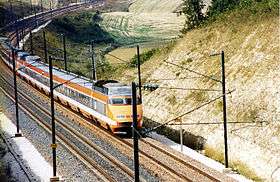SNCF TGV Sud-Est
The SNCF TGV Sud-Est or TGV-PSE was a French high speed TGV train built by Alstom and operated by SNCF, the French national railway company. It is a semi-permanently coupled electric multiple unit and was built for operation between Paris and the south-east of France.
| SNCF TGV "Sud-Est" | |
|---|---|
TGV Sud-Est on a service to northern France, wearing the new Carmillon livery | |
.jpg) Second class interior | |
| In service | 1981-December 2019 |
| Manufacturer | GEC-Alsthom |
| Family name | TGV |
| Number built | 111 |
| Number in service | 0 |
| Number preserved | 4 |
| Number scrapped | 107 |
| Formation | 10 cars (2 power cars, 8 passenger cars) |
| Fleet numbers | 01–37, 39–69, 71–87, 89–102, 110–118 |
| Capacity | 350 |
| Operator(s) | SNCF |
| Depot(s) | 6 |
| Line(s) served | 2 |
| Specifications | |
| Train length | 200 m (656 ft) |
| Width | Motor car 2.81 m (9 ft 3 in) Trailer 2.904 m (9 ft 6.3 in) |
| Maximum speed | 300 km/h (186 mph) (originally 260 km/h or 162 mph) |
| Weight | 385 t (379 long tons; 424 short tons) (bi-current) |
| Power output | 6,800 kW (9,100 hp) @ 25 kV AC 3,100 kW (4,200 hp) @ 1.5 kV DC |
| Electric system(s) | 25 kV 50 Hz AC 1500 V DC Overhead catenary |
| Current collection method | Pantograph |
| Braking system(s) | Pneumatic and Regenerative |
| Safety system(s) | TVM 300/TVM 430 |
| Track gauge | 1,435 mm (4 ft 8 1⁄2 in) standard gauge |
History

The TGV Sud-Est fleet was built between 1978 and 1988 and operated the first TGV service from Paris to Lyon in 1981. Formerly there were 107 passenger sets operating, of which nine were tri-current (25 kV 50-60 Hz AC - French lignes à grande vitesse, 1500 V DC - French lignes classiques, 15 kV 16⅔ Hz AC - Switzerland) and the rest bi-current (25 kV 50–60 Hz AC, 1500 V DC). There are also seven bi-current half-sets - TGV La Poste - without seats which carry mail for La Poste between Paris, Lyon and Avignon. These are painted in a distinct yellow livery.
Each set is made up of two power cars and eight carriages (capacity 345 seats), including a powered bogie in each of the carriages adjacent to the power cars. They are 200 m (656 ft) long and 2.904 m (9 ft 6.3 in) wide. They weigh 385 tonnes (379 long tons; 424 short tons) with a power output of 6,450 kW (8,650 hp) under 25 kV.
When the trains were delivered they wore a distinctive orange, grey, and white livery. The last set to wear this livery was repainted in the silver livery similar to the TGV Atlantique sets in 2001. From 2012 trains will be repainted in the new SNCF Carmillon livery. The TGV Sud-Est sets can be easily distinguished from the TGV-Atlantique and TGV-Reseau versions by the break in the roof just above the cabin windows.
Originally the sets were built to run at 270 km/h (168 mph) but most were upgraded to 300 km/h (186 mph) during their mid-life refurbishment in preparation for the opening of the LGV Méditerranée. The few sets which still have a maximum speed of 270 km/h (168 mph) operate on routes which have a comparatively short distance on the lignes à grande vitesse, such as those to Switzerland via Dijon. SNCF did not consider it financially worthwhile to upgrade their speed for a marginal reduction in journey time.
In March 2012, set 951 was taken to London to advertise the Euro Carex project.
In February 2013 the TGV Lyria sets (110 to 118) designed for services to Switzerland, were taken out of service. These were replaced by TGV POS sets.
In December 2019, all TGV Sud-Est sets were retired from service. In early 2020, a farewell service which included TGV01 (nicknamed Patrick), the very first TGV train ever built. This train was painted in all 3 liveries that it used during its service.[1][2]
Usage
The TGV sets were originally used on services between Paris, Lyon, Marseille and other cities in the south-east of France. In 2013 there were still 55 TGV Sud-Est sets used on services to south-eastern France and cross-country services. Since late 2019, these sets were replaced by TGV POS.
Preservation
Four of the TGV Sud-Est cars are preserved
- No. 53 at Cité du train, Mulhouse.
- No. 57 at the former La Chapelle depot as part of the "Grand Train" exhibition 40.
- No. 61 by the Bischheim technicenter and intended for the Cité du train, Mulhouse
- No. 112 at the Railway Museum in Ambérieu-en-Bugey.
Gallery
 TGV Sud-Est at Paris-Gare de Lyon in original orange livery
TGV Sud-Est at Paris-Gare de Lyon in original orange livery TGV Sud-Est in 1984
TGV Sud-Est in 1984- TGV Sud-Est south of Dijon
- TGV Sud-Est set 101
 TGV Sud-Est set 01 in 3 liveries
TGV Sud-Est set 01 in 3 liveries
Fleet details
| Class | No. in Service | Year Built | Operator | Current Units | Notes |
|---|---|---|---|---|---|
| Series 23000 | 0 | 1978–1985 | SNCF | 01-37, 39-69, 71-87, 89-102 | Bicurrent No. 38 rebuilt as TGV La Poste No. 70 scrapped 1988 No. 88 rebuilt for TGV Atlantique testing No. 101 rebuilt for tilt testing Retired in December 2019 |
| Series 33000 | 0 | 110-118 | Tricurrent |
See also
- List of high speed trains
References
- "[SNCF] Farewell tour for Patrick, the first TGV train". Eng News 24h. 2020-02-07. Retrieved 2020-03-18.
- "Goodbye "Patrick", the oldest TGV in France". www.tellerreport.com. Retrieved 2020-03-18.
External links
- Spec Sheet (in French)